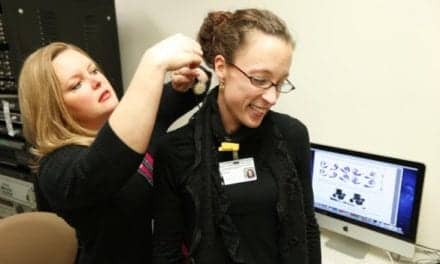With continued focus on refining cochlear implantation to deliver the most impactful benefits for patients at both ends of the age spectrum, clinicians at NYU Langone’s Cochlear Implant Center are harnessing advanced research in concert with acute surgical expertise to pioneer their application. In doing so, they are enhancing outcomes and quality of life in populations that, without cochlear implants (CIs), are at greatest risk for cognitive deficits, according to a post on the NYU Langone Health website.
Extending the Cognitive Benefits of Cochlear Implants in Older Patients
It is well-established that older patients with hearing loss face a paradox when it comes to intervention: cochlear implantation, the treatment that would improve their hearing while also lowering their risk for hearing loss–associated dementia, could also put them at risk for dementia associated with general anesthesia (GA). Since approximately 10-15% of older patients experience delirium following GA, which can progress toward dementia, only 5% of older patients with hearing loss previously met the criteria for CIs. Yet, a growing body of evidence shows that CIs can help prevent cognitive decline associated with age-related sensorineural hearing loss in patients for whom a hearing aid is not effective.
NYU Langone clinicians combined local anesthesia and conscious sedation (LA-CS) in cochlear implantation for the first time in 2006. The team has regularly performed the procedure ever since, establishing a mounting body of evidence of the approach’s efficacy and safety. NYU Langone reports that it is “the only institution in the United States able to offer LA-CS to every patient over 65 years of age seeking CIs.”
“Ninety-nine percent of patients over 65 years of age who consult with us for cochlear implants elect to receive local anesthesia and conscious sedation,” notes J. Thomas Roland Jr, MD, the Mendik Foundation Professor of Otolaryngology, chair of the Department of Otolaryngology—Head and Neck Surgery, and co-director of the Cochlear Implant Center. “Not only does it expand the availability of cochlear implants as a treatment option for more fragile patients, but it reduces the risk of dementia for every older patient by addressing hearing loss without the use of general anesthesia.”
Study Supports Local Anesthesia as a Safe Alternative
In light of the increasing occurrence of bilateral, age-related sensorineural hearing loss in an aging population—currently impacting 17-43% of patients 60 to 69 years of age—Dr Roland and his research team conducted a retrospective chart review of 100 older patients who underwent cochlear implantation with LA-CS between 2013 and 2020. The patients were age-matched with a control group of 50 patients who received CIs under GA in order to compare time in the operating room, time in the post-anesthesia care unit, and the rate of adverse events.
The review, published in 2020 in The Laryngoscope, confirmed that cochlear implantation under LA-CS provides a safe, feasible, cost-effective alternative to surgery under GA when performed by experienced surgeons. The approach reduces surgery time by an average of 20 minutes and cuts operating room time by an average of 37 minutes—which could save up to $1,369 in unnecessary costs per case. Adverse events were rare and relatively minor in nature, and patient satisfaction scores were notably higher in the LA-CS group than in the GA control group.
Skill Drives Sedation as Care Standard
Though the data collected by Dr Roland’s team could support expanding the use of LA-CS in patients at other centers, he cautions that because the approach requires an accelerated timeline, 40% faster than a GA procedure, it demands a high degree of skill cultivated by experience.
“Success with local anesthesia and conscious sedation depends not only on the surgical skill required to perform the operation itself, but on the surgeon’s ability to simultaneously recognize and address subtle nuances in patient behavior that could have an impact on the procedure,” said Roland.
For example, up to 10% of patients experience nausea and vertigo when the semicircular canals are reached. Over time, Dr Roland has refined his intraoperative management of these symptoms with quick interventions, such as warm irrigation and diazepam. “I keep one of my arms on the patient’s shoulder while I’m operating so I can feel if they tense up due to a symptom they’re developing,” Dr Roland said. “I need to keep the operation on pace, so I manage the symptoms as they arise, before they become a bigger problem by slowing or interrupting the procedure.”
Harnessing the Benefits of Cochlear Implants at an Earlier Age
At the opposite end of the age spectrum, in March 2020 the US Food and Drug Administration (FDA) lowered the age indication for a commonly used CI device from 12 months to 9 months, a decision supported by more than 10 years of NYU Langone research. Studies have demonstrated significant cognitive benefits associated with early cochlear implantation for children, helping to narrow the development gap between children born deaf and normal-hearing peers.
“Over a decade, we’ve developed a strong case, which led the FDA to take this meaningful step,” noted Dr Roland. “The action was taken based on our convincing body of evidence demonstrating not only positive outcomes from the hearing improvements associated with cochlear implants, but the proven cognitive benefits they convey to children when implantation is performed at an increasingly young age.” Such improvements include earlier speech production, which can help to prevent the irregularity known as “deaf speech” that arises from longer term hearing impairment.
Studies have suggested that children who receive CIs are capable of the communication skills of their peers by the time they reach age 7. “However, we have data showing that our patients implanted under age 1 are then on par with typical-hearing kids in language development at 2 or 3 years of age, and this expedited timeline of achieving hearing improvement can help to foster other cognitive and developmental advantages,” explained Dr Roland. “Those early data convinced us that implantation under age 1 was the right thing to do.”
Sharing Surgical Insight to Expand Early Adoption
Similar to cochlear implantation with LA-CS in older adults, implantation in children under 12 months requires a high degree of surgical skill garnered through neurotology training and extensive firsthand experience. “You’ve got to be quick, you need to know what you’re doing, and you must understand the unique aspects of anatomy and physiology of a baby compared to those of an adult,” said Dr Roland.
To date, the department has performed cochlear implantation on more than 350 children under 1 year of age, with an average simultaneous bilateral CI case time of 90 minutes. Based on this experience, Dr Roland has developed a robust presentation that details the anatomical and physical issues involved, in order to enhance access to CIs for pediatric patients worldwide. “It’s important to share information on the surgical technique and outcomes of cochlear implants in infants because neuroscience research indicates that the sooner you give this young, plastic brain auditory information, the better these children will do—and every child whose condition would benefit should have this advantage,” he said.
Original Paper: Connors JR, Deep NL, Huncke TK, Roland JT. Cochlear implantation under local anesthesia with conscious sedation in the elderly: First 100 cases. The Laryngoscope. 2020. DOI: https://doi.org/10.1002/lary.28853.
Source: NYU Langone Health, The Laryngoscope
Image: NYU Langone Health Staff





